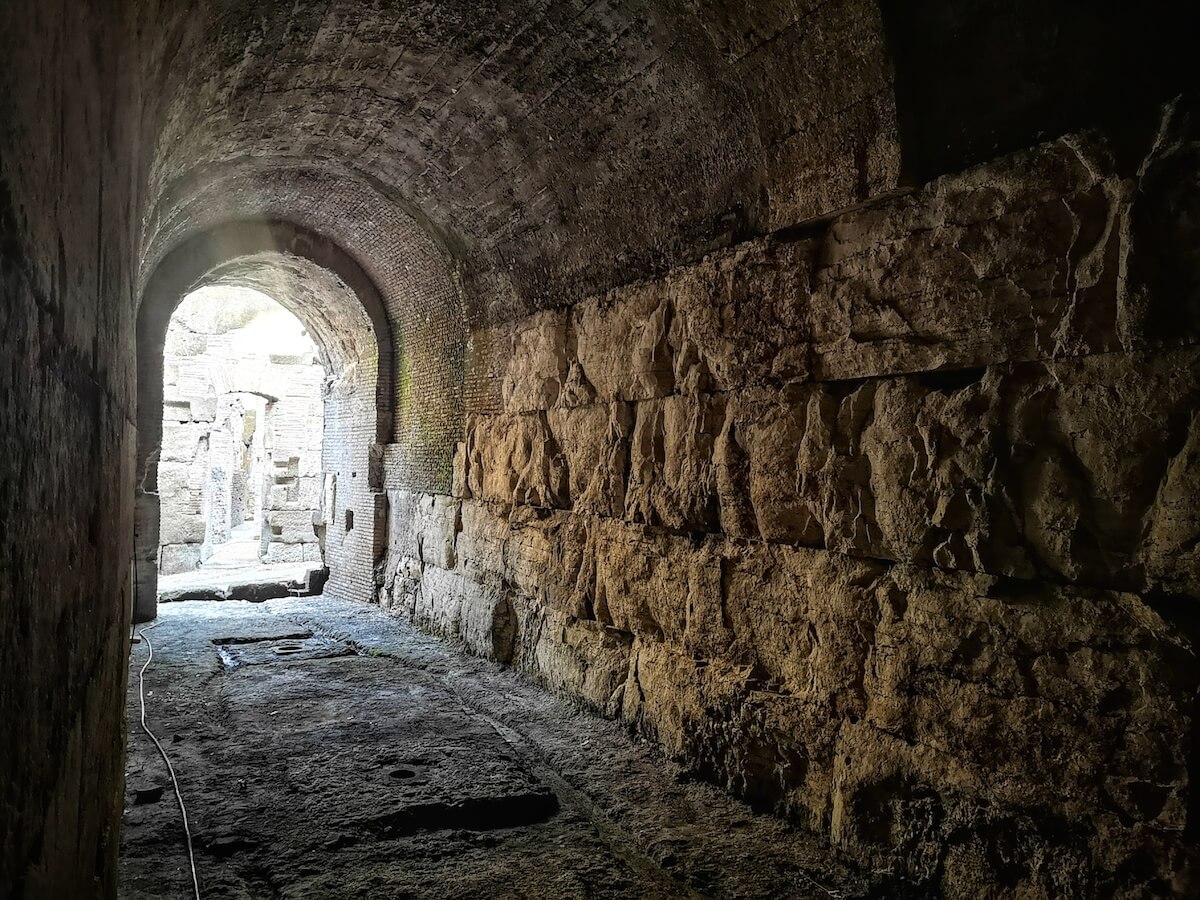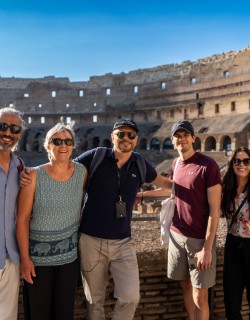If you’re like us, you’re awaiting the upcoming sequel Gladiator II with no little impatience. It’s been 25 years since Ridley Scott’s jaw-dropping blockbuster redefined the sword and sandals epic for the new millennium; in the hotly anticipated trailer for the follow-up, Paul Mescal straps on his leather sandals and sexy cuirass as he tears a course through ancient Rome in an attempt to win his freedom.
Amongst the deadly obstacles he has to overcome is a truly spectacular sea battle that takes place in the flooded arena of the Colosseum. It looks amazing, but is this just a flight of Hollywood fancy or did such events actually happen in the ancient amphitheater? We investigate the truth behind the fiction.
Did the Ancient Romans Really Stage Deadly Sea Battles?

Mock sea battles did indeed form a staple part of the entertainment at the games in ancient Rome. Known as naumachiae, these gruesome spectacles were a bizarre and cruel mix of historical charade and capital punishment.
Although the ancient sources are somewhat spotty, we know that the battles pitted crews of slaves, condemned criminals and prisoners of war against each other in reenactments of famous maritime battles from ancient Greece. Spectators could literally feel history come alive as Corinth did battle with Corcyra, say, or watch the battle of Salamis unfold before their very eyes.
As can be readily imagined, the resources and technical solutions required to stage such sea-battles were immense, and so naumachiae were only performed in the most important games - those sponsored by the emperor himself to mark special occasions.
A Brief History of the Naumachiae

Naumachiae were a staple of the Roman entertainment schedule for only a relatively brief period of around 150 years. The first securely-recorded mock sea-battle was staged in 46 BC as part of the celebrations associated with Julius Caesar’s unprecedented quadruple triumph, which marked the general’s quickfire victories in Gaul, Pontus, Africa, and Egypt.
Suetonius recounts that Caesar’s naumachia simulated an ancient conflict between the maritime powers Tyre and Egypt in a temporary basin dug out near the Tiber river. Fully 6,000 men were forced to take on the doomed roles of oarsmen and soldiers. These were prisoners of war captured by Caesar’s troops and sentenced to death.
No less impressive was the mock sea battle staged by the Emperor Augustus in 2 BC as part of festivities staged to mark the construction of a temple dedicated to Mars, god of war. Thousands took part in this re-telling of the battle of Salamis, a glorious Greek victory over the Persians in 489 BC. Augustus had a custom-built arena built specifically for the purpose of staging his naumachia, which was provided with water by a new aqueduct called the Aqua Alsietina.
Half a century later, the emperor Claudius upped the ante still further. To celebrate the completion of a canal that would enable the draining of the Fucine lake - one of the most impressive feats of ancient Roman engineering ever attempted - Claudius organized an extravagant naval battle comprising 19,000 would-be soldiers representing Rhodes and Sicily, divided amongst two fleets of 50 ships each, on the waters of the soon-to-disappear lake.
Where did the Sea Battles Take Place?

As noted above, a number of custom-built venues were constructed to stage the conflicts during the 150-year heyday of the naumachiae. These arenas took the form of wide shallow basins located near a ready supply of water. Thankfully, ancient Roman engineers were highly expert in hydraulics, and the series of aqueducts that funneled fresh water to the city could also be deployed to provide the infrastructure for the naumachiae.
The grandest of the sites was the Stagnum Augustae, a massive pool measuring 536 meters long and 357 meters wide, immersed in a grove of trees and surrounded by grandstands which was fed by a new aqueduct that the emperor incredibly had built just for this purpose.
Archaeological evidence drawn from across the Roman empire also indicates that sea-battles were sometimes staged in smaller venues, typically the mighty stone amphitheaters that were a distinctive feature of the major Roman cities - like the Colosseum.
Did Sea Battles Take Place in the Colosseum?

We know for certain that naumachiae played a big role in the inaugural games marking the opening of the Colosseum, then known as the Flavian Amphitheater. Ancient writers including Martial and Suetonius tell us that the presiding emperor, Titus, arranged for a reenactment of a naval conflict between Athens and Syracuse. This naumachia seems to have taken place at the still operational bespoke arena built by Augustus 80 years earlier, however.
Roman sources also indicate that another sea-battle, this time representing a famous battle between Corcyra and Corinth, did in fact take place in the Colosseum itself. The poet Martial imagines the shock of a late-arriving spectator witnessing the vast amphitheater suddenly transform into open sea:
“If you are a newly arrived spectator from distant lands, don’t let the goddess of naval warfare deceive you with these ships, or the water that’s like the waves of the sea - here, a moment ago was dry land. Don’t believe it? Look on, whilst the waves fatigue the god of war. After a little while you will say, "But here there was lately sea.”
What About the Colosseum Underground?
But there is a problem: the Colosseum as we know it today, with its underground section consisting of a warren of rooms that were filled with complex machinery enabling the games to function, could never have been flooded with water to enable the sea spectacles to take place. For this reason some authors believe that the ancient writers were taking poetic license and that this naumachia also took place in Augustus’ arena. Others believe that the Colosseum naumachia was little more than a stage show rather than a fully-fledged battle.
Current academic consensus is that the sea-battles really did take place at the Colosseum during the inaugural games, however. As the underground area hadn’t been completed when the first games were held, there is no good reason to believe that the Roman engineers didn’t have the wherewithal to flood the arena to stage a naumachia, albeit on a reduced scale. Furthermore, a ready supply of water would have been available as the amphitheater was built over the site of the artificial lake that served as the centerpiece of Nero’s destroyed Domus Aurea.
Martial closes his account with the claim that the Flavian Amphitheater was the greatest site for mock sea-battles ever created: “So no more of Fucinus and the lake of direful Nero. Let this be the only sea fight known to posterity.”
Writing around a century later, Cassius Dio also affirms that naumachiae took place in the Colosseum, adding that a bizarre wild animal hunt was also performed in the flooded amphitheater: “Titus suddenly filled this same theater with water and brought in horses and bulls and some other domesticated animals that have been taught to behave in the liquid element just as on land.”
Eagled-eyed watchers of the Gladiator II trailer will have noticed that the Colosseum features some exotic wildlife, but Ridley Scott's imagination takes us a long way from Cassius Dio and historical record - we can say with 100% certainty that man-eating sharks were not scudding through the flooded arena!
The Colosseum’s battles were amongst the final naumachiae, and the construction of the underground hypogeum beneath the amphitheater rendered further events like this impossible here. Domitian is recorded to have organized a sea-battle in another purpose-built structure in 89 AD, but after this no further unambiguous references to the practice exist.
How did the Sea Battles Function?

Whilst we know the naumachiae really took place, we know very little for certain about how they actually functioned. Some scholars maintain that the battles were more like elaborate plays with sophisticated props, but given the detailed accounts in ancient sources that list the numbers of combatants and casualties, most historians believe that the Romans really did pit actual fleets against each other in miniature ships.
Although the naumachiae weren’t real military conflicts, they were certainly plenty bloody. It seems that these were in fact amongst the most brutal and deadly events that ancient Roman entertainment could offer. Unlike the highly motivated and professional gladiators - for whom survival and eventual freedom was a real possibility, and whose battles weren’t necessarily to the death - the amateur participants of the naumachiae were typically prisoners of war or other undesirables already condemned to die. Their only chance of short-term survival was to fight their way out.
As full-sized Greek and Roman warships measured upwards of 35 meters in length, the 75-meter-long Colosseum could have only accommodated scaled-down versions of history’s galleys and triremes. Given the small dimensions of the arena and the sheer number of miniature ships and soldiers involved, it seems likely that the sea-battles in the Colosseum would have been chaotic and bloody free-for-alls, far from the organized tactical refinement of real naval encounters.
Whether the combats were rigged to ensure that the battle aligned with historical reality is unknown, although this seems unlikely as Cassius Dio asserts that in one of the Colosseum’s battles Athens managed to defeat Syracuse - flipping the script of historical record.
How Long Did it Take to Flood the Colosseum?

We must also take the claims that the Colosseum could be flooded and drained quickly enough to allow for nautical and dry-land spectacles to take place rapidly one after the other with a pinch of salt. Regardless of the extraordinary hydraulic abilities of ancient Roman engineers, the technology required to guarantee an adequate water pressure to flood the arena to an adequate depth in such a short time and drain it just as quickly didn’t exist.
Latest estimates suggest that the Colosseum could feasibly have been flooded in a matter of hours rather than minutes - certainly impressive, but not quick enough to facilitate the blink-and-you’ll miss it transformation described by Martial. Of course, as the programme of the games lasted all day this wasn’t necessarily a fatal problem. Alternatively, non-water based events could have taken place on a temporary wooden platform built over the already flooded basin of the amphitheater, allowing for a freer mix of land and sea based combat.
So there you have it. Whilst historical evidence for exactly how sea battles worked at the Colosseum is lacking, we can confidently say that naumachiae played a role in the lavish entertainments that took place at the amphitheater during the inaugural games in 80 AD. Whether they were quite as spectacular as the upcoming events of Gladiator II is another matter!
MORE GREAT CONTENT FROM THE BLOG:
- How to Visit the Colosseum in 2024
- Gladiators in the Colosseum: An Introduction
- Did the Colosseum Have a Roof?
- 5 Fascinating Facts About the Colosseum's Arena Floor
- The Colosseum Underground: The Deadliest Show on Earth
- The Best New Tours of Italy in 2024
- Where to Stay in Rome in 2024: Areas and Hotels Guide
For 25 years, Through Eternity have been organizing expert-led tours to the Colosseum and Ancient City. If you're planning a visit to the Eternal City, check out our range of Colosseum itineraries!







